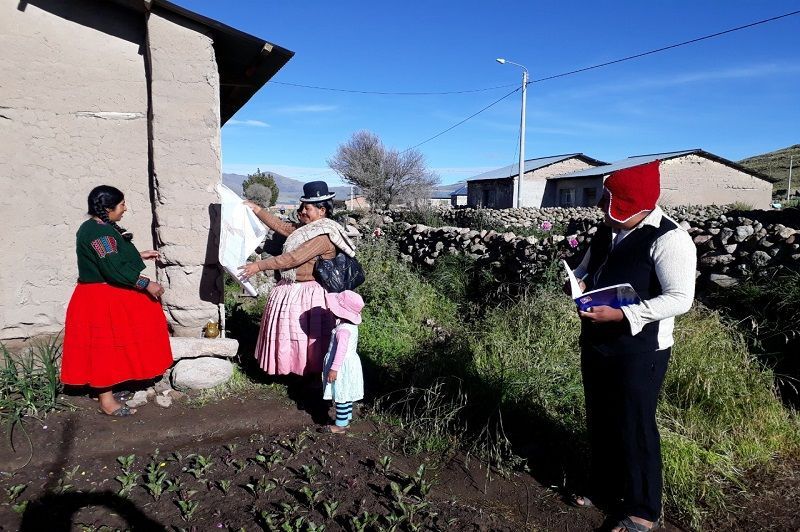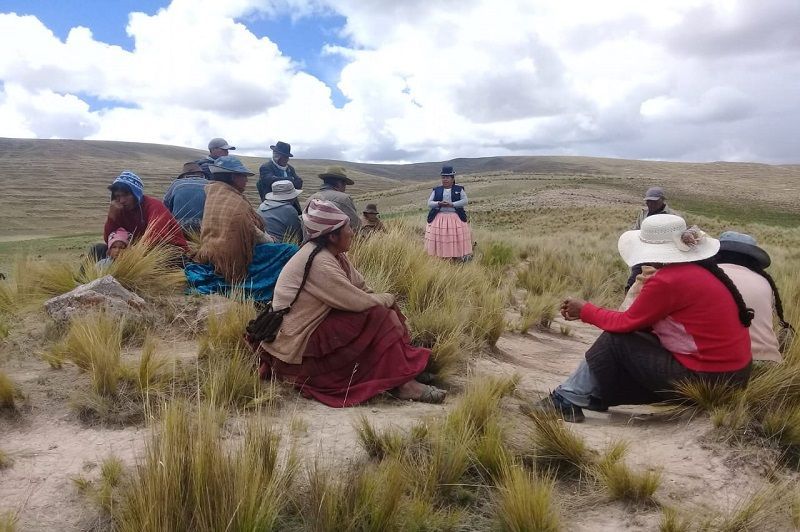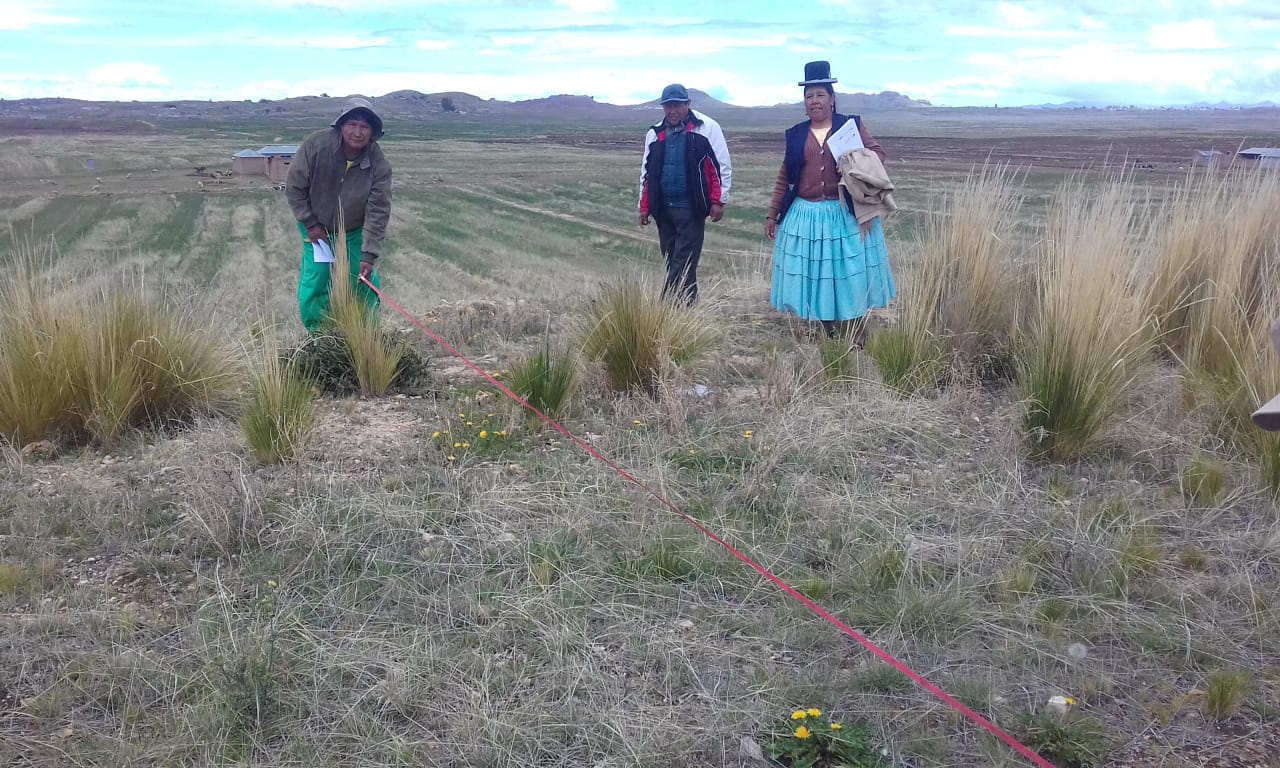Isabel Gomez is a Peruvian leader, who loves living near Lake Titicaca. She is part of the Pacha Yachay project that EUROCLIMA+ finances through its Disaster Risk Management sector.
Ilave District, El Collao Province, Puno Region, Perú.
Isabel Gomez is a Peruvian leader, who loves living near Lake Titicaca. She is a woman who combines her scientific knowledge of Climate Change with ancestral practices guided by her sensitivity to Mother Earth (Pachamama). These actions have allowed her to face the challenges of agricultural production and implement sustainable and environmentally friendly practices.
The Peruvian Altiplano is over 3,600 meters above sea level and has an arid climate. Both conditions make it difficult to plant crops and raise livestock. However, for Isabel, living near Lake Titicaca has been a valuable opportunity to learn about the culture and practices of her ancestors since she was a child.
From her role as trainer for EUROCLIMA+'s Pacha Yatiña, Pacha Yachay project, Isabel promotes the development of skills for the care and management of resources such as water, among families in the area.
This leader believes that integrating 'dialogue with Pachamama' is central to decision-making on agricultural activities implemented in the countryside.

The main challenge of the area is to make the most of periods with rainfall and it is here that the ancestral practices of connection and harmony with the environment are introduced for the prediction of climate and weather, through the observation of behaviour patterns in other living beings or “biological signs”.
Isabel explains that in order to forecast the weather and thus make decisions during the agricultural season, it is important to refer to the signs provided by some plants, or the behaviour of some animals. In the case of plants, the kañiwa plant, for example, is tolerant of rain deficit conditions, being a species related to rainfall. The sancayo is an Andean cactus species, native to Bolivia, Peru and Chile, whose flowering is related to the planting season; in turn the huaycha, is a plant known in the Quechua area as "muña", which allows defining the early, intermediate and late planting season by observing its flowering
Animal signs also allow us to understand the behaviour of the climate. For example, the lequecho is a typical bird of the Andean region that, depending on where it lays its eggs, allows us to know if there will be high or low intensity rainfall during the month. In this context, the pispillauchi or Andean sparrow is a bird whose song alerts producers in the Aymara communities to the occurrence of frost, and is a highly appreciated indicator in the farms.
Isabel contributed to families and communities by passing on her knowledge of these and other signs, where people from the municipalities of Ilave, Mañazo, Pusi and Taraco shared valuable experiences, as well as proposals for the use of resources. Among the various experiences, the installation of composters to replace the use of fertilisers, the implementation of drip, sprinkler, and evaporative irrigation, as well as water planting and harvesting actions stand out.

From her experience, Isabel explains the development of farmer competitions where learning was shared. "The first ten places (in the competition) have achieved the fulfilment of 80% of the proposed activities. For example, they were able to harvest water by installing water tanks in their houses, which made it easier for them to raise small animals," explained the leader.
Recognised for her wisdom linked to ancestral practices, Isabel claims to have learned and gained experience in water harvesting, hills, and wells; but above all in understanding what climate change is and ways to deal with it.
She, as a Yachachi from the Peruvian highlands, demonstrated that it is possible to work from the upper, a middle and lower basin hand in hand with the community, to move forward in the present and look to the future with wisdom, resilience and hope.
The bi-national project "Information, governance and action for drought risk reduction in Peru and Bolivia in a context of climate change" - Pachayatiña/Pachayachay, is being implemented between Bolivia and Peru by the consortium made up of SENAMHI Bolivia, SENAMHI Peru, HELVETAS Swiss Intercooperation programmes Bolivia and Peru, and PREDES, with the aim of reducing the risk of agricultural losses caused by drought, in a context of climate change in the highlands.
About the Disaster risk management sector: droughts and floods
The sector "Disaster risk management and reduction: droughts and floods" aims for the adoption of disaster risk management and reduction plans by national governments in Latin America to promote integrated management of flood and drought risks in the context of climate change, taking as a reference the Sendai Framework for Disaster Risk Reduction 2015-2030, and the commitments adopted by countries in their fight against climate change. See information on the sector: https://www.euroclima.org/en/risk-management
This sector of EUROCLIMA+ is promoted by two implementing agencies: the Spanish Agency for International Development Cooperation (AECID) and the French Development Agency (AFD).
Isabel Gomez is a Peruvian leader who loves living near Lake Titicaca
For more information:
This email address is being protected from spambots. You need JavaScript enabled to view it.

